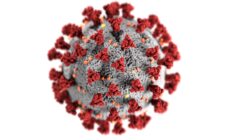Chronic obstructive pulmonary disease (COPD) is the disease affecting the lungs (main respiratory organ) with the characteristic obstruction in the airways, leading to breathing difficulties. It is also known as the chronic obstructive lung disease. COPD is one of the dangerous diseases in the world leading to death. It is the chronic permanent condition mostly irreversible and incurable. The conditions associated under or making up COPD are 1) Chronic bronchitis Chronic bronchitis is the condition of the damage or inflammation of the bronchi and bronchioles. This inflammation makes the thickening and narrowing of the airway and making the reduction in airflow in and out of the lungs. 2) Emphysema Emphysema is the condition of the inflammation of the lung area distal to the terminal bronchioles. Mainly the air sac (alveoli) is affected. Alveoli are the area where the oxygen and carbon dioxide exchange between blood and air takes place. Reduction in oxygen supply to the blood. 3) Asthma Asthma is the narrowing of the airways of the lungs making the difficulty in the breathing process. Usually the asthma is reversible and curable. But the chronic bronchitis and the emphysema are permanent and irreversible.
Causes and risk factors for COPD:
-
- Main cause for COPD is continuous cigarette smoking – chain smokers have the airways narrowed and lung filtration process is disturbed to a great extent. Tobacco smoking is the most dangerous one. About 85% of COPD is due to smoking.
-
- Subsequent hand smoking – this is the main route for infections through the second handed smoking.
-
- Air pollution – BIOLOGICAL POLLUTANTS like pet dander, dust mites are easily transferred in air to produce COPD. Carbon monoxide emitted from the fuel sources for fire.
-
- Hypersensitivity of the lung airways for the air infectious irritants.
-
- Genetic factor – insufficiency of alpha 1antitrypsin protein produced by the liver
-
- Few irritating chemical fumes – leading to cough and allergies
- Allergic to dust and other chemicals and other exposures
Signs and symptoms:
-
- Chronic cough – Main symptom of COPD. Cough is the reflex action for the substance like mucus formation obstructing the airways.
-
- Shortness of the breathing process due to decreased oxygen flow and content in blood stream.
-
- Wheezing – due to obstruction in the airways a whistling sound is heard during the breathing process.
-
- Chest tightness is felt with some pain or discomfort leading to the shallow breathing.
-
- Sputum formation – sputum is formed in the lungs and is cleared through cough reflexes. The consistency and the color of sputum show the type f COPD acquired.
-
- Blood along with mucus in the cough.
-
- Cyanosis – lack of oxygen leading to blue colorization of the skin texture.
-
- Clubbing – long term oxygen insufficiency leading to loss of nail angle usually downwards.
-
- Few unusual weight losses – loss of weight is unnoticed by the COPD patient.
-
- Fatigue (tired) – feeling of tiredness all through the days.
-
- Long time lung infections – some infectious conditions may be progressive or affecting the lungs for longer period of time by less air flow in the lungs.
-
- Reduced exercise capacity – exertion or discomfort felt with slight exercise or physical activity.
- Barrel chest in the late stage of emphysema
Diagnosis methods:
In diagnosis of COPD doctors do certain physical exams and enquire for the family, job nature, life style etc… to suspect for COPD. PULMONARY FUNCTON TEST: The four main components of the pulmonary function tests are
-
- SPIROMETRY – this test determines the obstruction in the lung airway leading to COPD by measuring the in and out flow of air.
-
- POSTSPIROMETRY – This test is done after the administration of the bronchodilators to determine the airways response to medications and their reversible capacity
-
- LUNG VOLUME – mainly the residual volume and total lung capacity are measured to find the damage to the lungs.
- DIFFUSION CAPACITY – this is to see the gases switch over from alveoli to the capillaries
ARTERIAL BLOOD GAS TEST: This blood test is done to determine the oxygen and carbon dioxide level in the blood and the acidity of blood (ph) taken from the artery. The partial pressures of the oxygen and carbon dioxide are measured CHEST X-RAY: This shows the abnormality in the lungs size and rule out the other conditions of lungs. Only in the severe conditions chest x-ray shows its accuracy. SPUTUM CULTURE: This culture test is the technique to experiment or find the lung infections. CT SCAN: CT scan shows the images of heart and lungs and any variation in it. CT scan is only secondary to pulmonary function test to show COPD accurately. ALPHA 1 ANTITRYPSIN LEVEL: The level of alpha 1 antitrypsin shows the liver involvement and genetic interferences in the cause for COPD. BRONCHOSCOPY: This is done to access the inside of lung where there is obstruction in the lungs airways and with this method doctors determine the treatment modalities.
Management of COPD:
-
- The first thing in the treatment process is the avoidance of smoking completely.
-
- Avoid the exposure in the polluted air – use of mask in outdoor environment.
-
- Pulmonary rehabilitation – various team workers like physiotherapist, occupational therapist, psychology therapist, nurse care, respiratory specialist etc… are involved in the rehabilitation process
-
- Anti nicotine therapy with the antidepressant therapy
-
- Oxygen therapy – for the meet of the oxygen content in the blood
-
- Bronchodilators for the freeness in the breathing process by dilatation of airways. Few bronchodilators commonly used are ALBUTEROL, ATROVENT, TERBUTALINE, XOPENX, FORMOTEROL, SALMETEROL, ETC….
-
- Antimicrobials – TETRACYCLIN, AMOXICILLIN,AMPICILLINM,BACTRIUM
-
- Corticosteroid drugs – FLOVENT, SLOUMEDROL, PREDNISONE
-
- Aerosol therapy – using nebulizer to take drug in fine spray or mist form. It has the quick effect on lungs
-
- Antibiotics for certain infections
-
- Alpha 1 antitrypsin therapy – for deficiency in the production of alpha 1 antitrypsin by liver.
-
- Lung volume reduction surgery – Only in the severe cases of the emphysema lung volume reduction surgeries are done.
- In few severe cases lung transplantation are done.
Preventive measure:
-
- Reducing smoking and completely giving up smoking
-
- Avoiding exposure to the irritants of the lung tissue or airways
-
- Avoid contact or exposure to the harmful chemicals and fumes irritating the lungs.
-
- Follow a daily diet plan targeting heart and lungs.
-
- Regular exercise program to make breathing easier.
-
- Healthy natural life style with clean air
-
- Immunizing against certain infections of the lungs by annual vaccine administration.
- Avoiding environment with dust and pollutants in the air.
Conclusion:
COPD is the irreversible permanent condition of the lungs. But there are various therapies and medications available in the rehabilitation program to manage or control the risk factors and symptoms.





